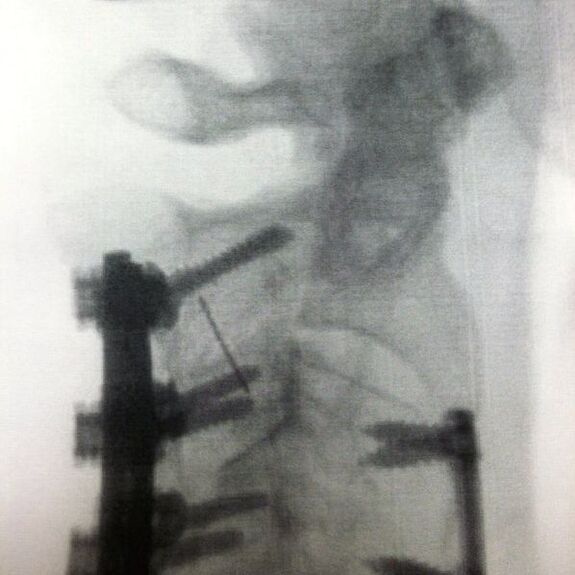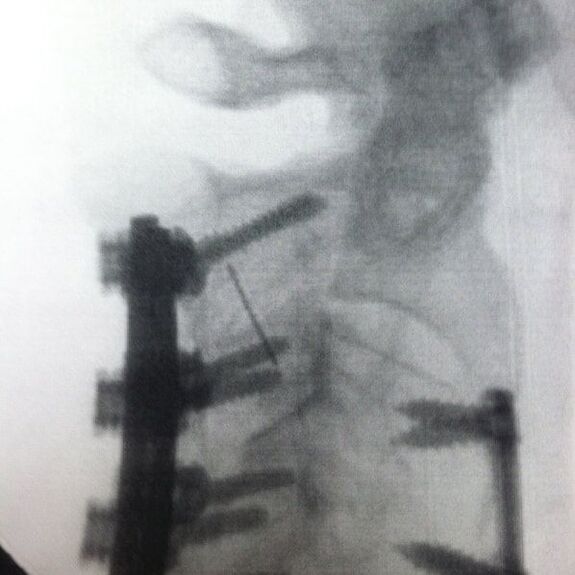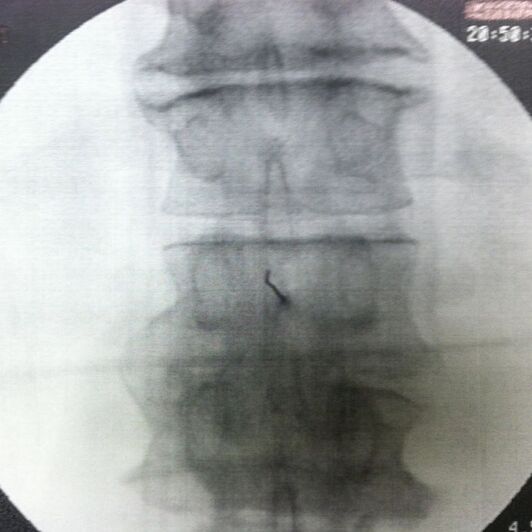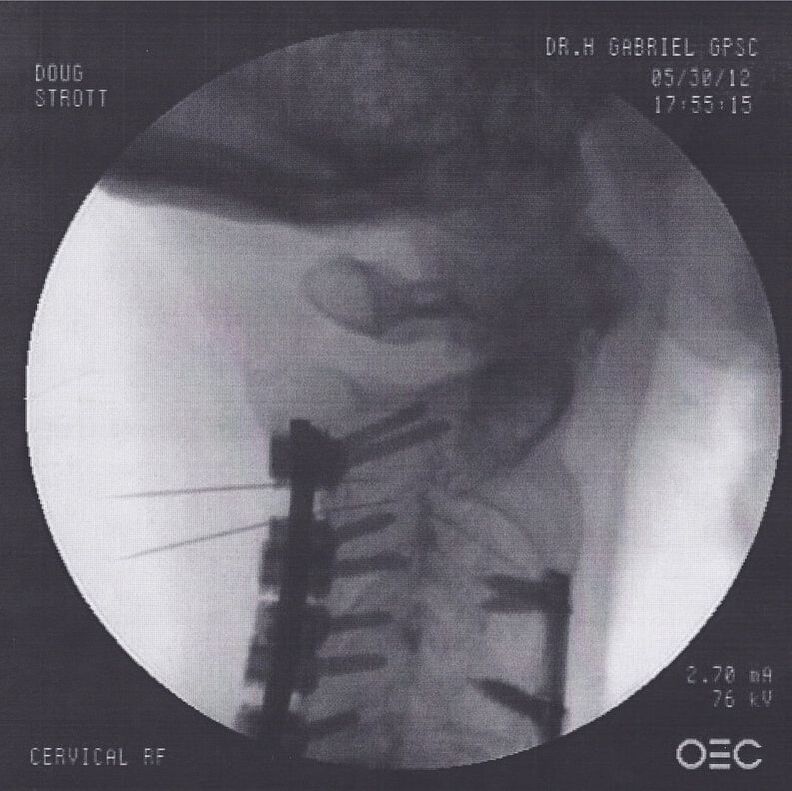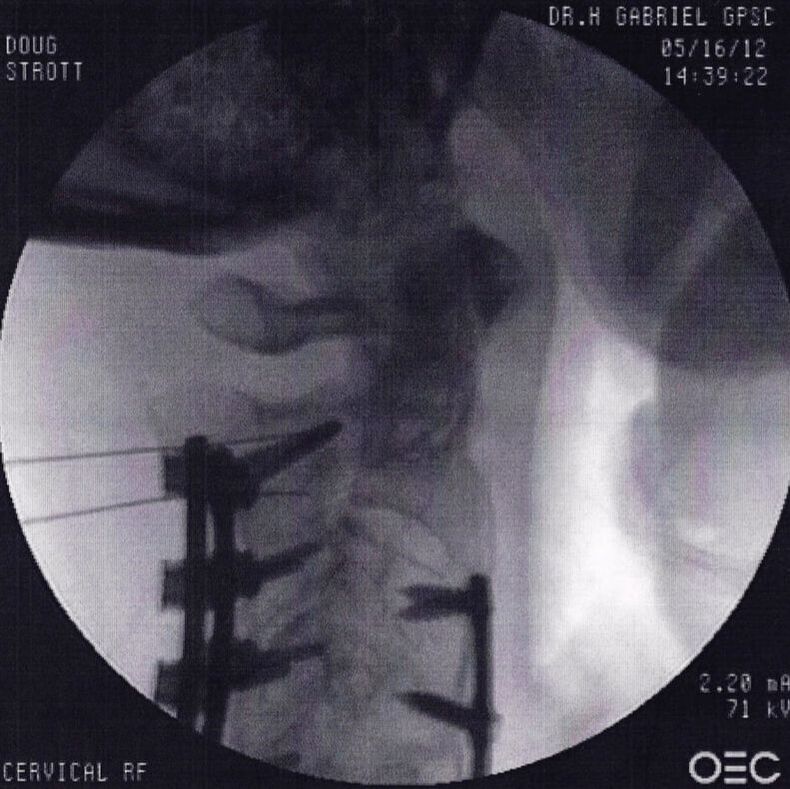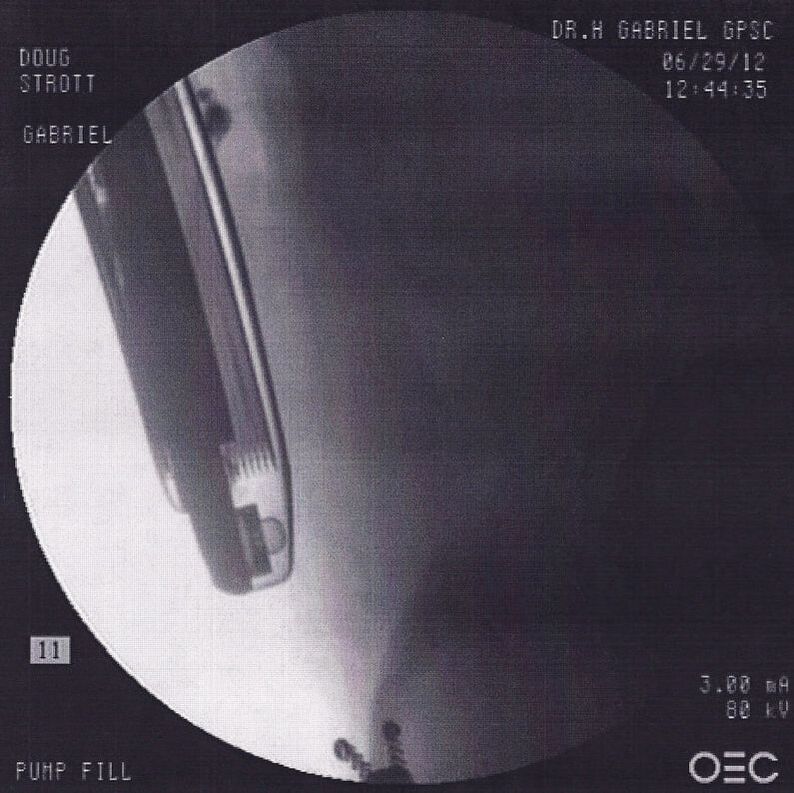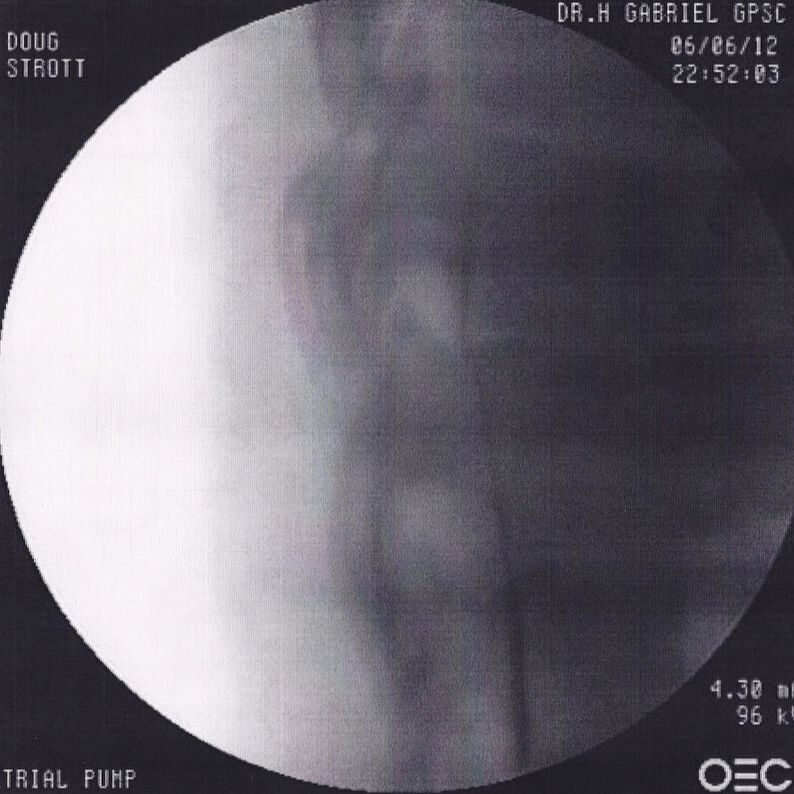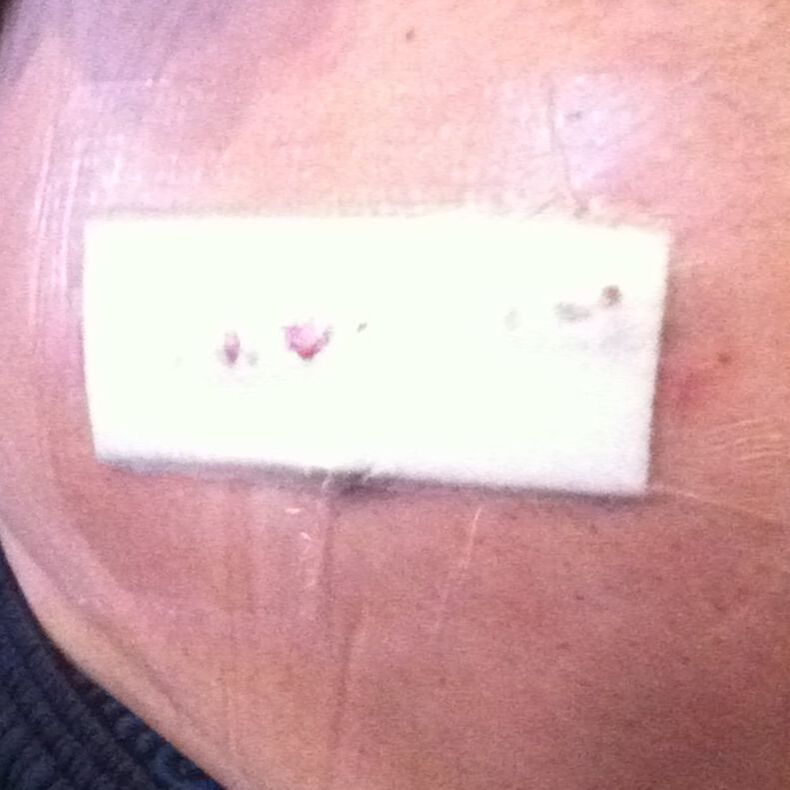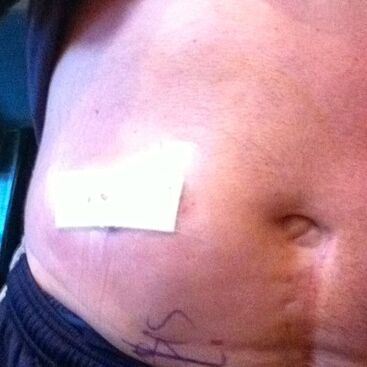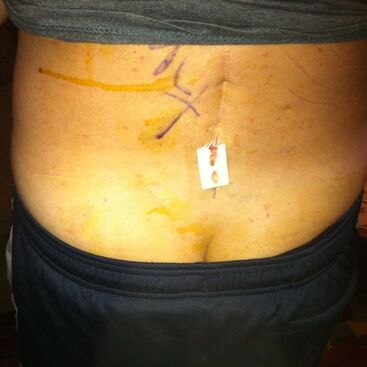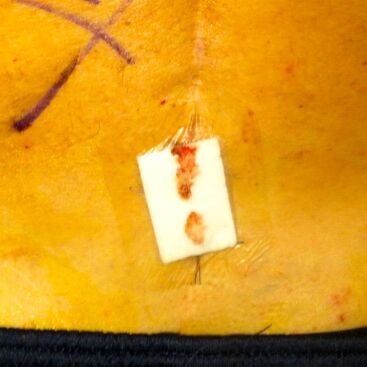My Treatments
I was diagnosed with Scheuermann’s Disease (SD) in 1981 when I was 17 years old.
At the time, I was running Track and Field in High School and my event was the javelin. This event required me to perform a set of exercises that I had never done before, most involving unusual stretches of different back muscles. Some of these exercises caused unusual pain, and some I was unable to do at all, so the Coach recommended that I see a specialist for an examination to evaluate the root cause of the pain. That was when the diagnosis was made that I had Scheuermann’s Disease.
The post-diagnosis treatment regimen from the Orthopedic Spinal Surgeon included a set of core exercises and it was also recommended that I refrain from getting a gut, or beer belly. The excess weight in my stomach area would destabilize my lower back and add to my existing pain.
The doctor also explained the problems involved with my spine, that since the curve in my back is lower than normal, it threw my head and hips out over my body, adding stress to my cervical and lumbar discs and vertebrae.
For my lumbar, he asked me to imagine bending a metal plate back and forth, over and over again. That was happening to my lumbar vertebrae due to the physical stress applied to them from the accentuated curvature. In addition, calcium deposits were building up in the vertebrae and they would thicken over time making them more brittle. These exercises were designed to potentially build up the muscles in my lower back and stomach to try to partially straighten my back, but since my bones had already formed, the success would be very limited.
After a few years of keeping my weight down, following the exercise regimen, and strengthening my back, my Orthopedic Spinal Surgeon prescribed me a Milwaukee Brace that was to be worn during waking hours continually for a year (this was when I was 20 years old). I named it “Fred”.
For those of you who are not aware of what is involved with a Milwaukee Brace, a plaster mold was made of my body from my hips to under my arms. Once the mold hardened, it was then cut off and the mold was used to make a plastic replica of my midsection. The brace replica of my midsection had three straps that could be tightened once fit around my body. Not the most comfortable of devices, but I did wear it during waking hours. Funny, I can still remember sweating continuously in all types of weather because there wasn’t any breathability to the thick plastic material. It also caused this wrenching pain in my lower back every time I sat down for any period of time, regardless of how much I adjusted my posture. It was really uncomfortable, but my only option. It also made me look like I was wearing a hard-boiled egg if you looked at me from behind because the bottom of the shell almost covered by butt.
I was in college at the University of Pittsburgh-Johnstown during my brace-wearing years and recall sitting through classes, some of them 3 hours long, with Fred cutting into my hips and chest, sweating, and losing any body fat that I had ever gained. The cosmetic part of the brace didn’t really bother me at all, although I did have to answer a lot of questions from people who wondered what the brace was all about. Unfortunately, I couldn’t provide much information to them other than the name of the disease because there wasn’t any public information out there for me to relay. Nada.
There are some funny memories about this time in my life, though. Like when one of my best friends, Gilbert, would grab me from behind by the top of the brace and swing me around until I fell on the ground. Or when I would be sitting on a bench and he would come up to me and just ever so lightly push me backwards. My arms would flail, and I’d fall back, looking like a turtle on its back. Yeah, a lot of fun. Actually, it was a riot. If you can’t laugh at yourself, who can you laugh at?
The year of the brace flew by and at the final appointment with my doctor, he said that “the brace did what it was supposed to do and it wouldn’t help by wearing it for a longer period of time.” He instructed me to be careful with my back, listen to it, and that I may, or may not, have problems in the future.
Problems and pain did happen, slowly and noticeably, piece by piece. From not being able to play basketball, to no sports at all, to not being able to walk through a mall without pain, to not being able to walk at all without pain….and so on. I had no idea what the future held for me.
“I was praying, praying to believe, there was something for, something more, out there waiting for me.”
Joe Bonamassa, “Waiting for Me”
Over the years, it has been difficult at times to keep my spirits up, especially when the pain is unbearable. Trying multiple treatments with no pain relief only adds to the frustration (which does not come close to describing this aggravating process).
I have read research studies about former professional athletes who struggle in similar ways as those of us with Scheuermann’s Disease. These individuals face psychological and physical effects caused by retirement from sports at an early age, the only passion they have ever had or known, as well as their lives often being linked to severe chronic pain.
Their realization of a dream, now lost, was often followed by two to three years of strong negative emotions, that included anger, denial, frustration, fear, and sadness. Many spent time continually exercising, trying to work their way through the pain like they did when they were younger, when their bodies healed much more quickly. Eventually, this exercise exacerbated the situation by causing their already shredded nerves to become more angry and irritated, the healing process slowed down by age, thus causing more pain and adding to the already whirlwind of emotions. This sometimes led to self-medication with alcohol and prescription medication, adding fuel to the fire with all those emotions of having to leave the jobs they loved and needing to find a new passion in life.
These athletes are no different than those of us with SD who have had to leave our life’s work prematurely due to pain and/or disability. We go through the same emotions and trauma, asking the same questions: Why me? What did I do?
However, there was one common thread with the men and women survived this spiral: a wonderful support group of loved ones. They leaned on these people for support, guidance, and love. They had family, friends, former work associates, peers, clergy, doctors, nurses, and/or therapists that cared deeply for their well-being. Without that, who knows what the outcome may have been.
That led me to open my eyes to see how blessed I have been, to have such people in my life to help me survive these difficult and painful times. The “creep” of seeing my mobility erode, the surgeries, the rehabs, the stares, the absolute white hot pain that never recedes. Crying night after night and knowing that my life was never going to be the same. Yup. No way I would have made it without the wonderful people along the way.
“The two most important days in your life are the day you are born and the day you find out why.”
Mark Twain
It took me a couple years to realize that because I am not what I used to be, doesn’t mean that I am nothing.
It started during my surgeries and trying to research Scheuermann’s Disease on the internet. I wanted to learn as much as possible about the disease so I could learn what my future held for me. There wasn’t much out there. It felt like I was at the card catalog in the local library all over again. Limited research, limited information, hardly any studies for adults, and I kept reading that this was a benign disease.
Wait a minute. I was in the middle of 5 serious spinal surgeries in 3 years (these surgeries are documented here: www.sdfund1.org/#!founders-experience-with-sd/c4xz), the pain sucks and this is a benign disease!
[On a side note, after my final cervical/thoracic revision fusion surgery, I was given a Bone Growth Stimulator (www.spineuniverse.com/resource-center/bone-growth-stimulation/patient-guide-bone-growth-stimulation). These devices are typically used in cervical and lumbar areas and cases where the patient’s (me) body has difficulty in the fusion process and at multiple levels. The stimulator works by sending low level electrical signals, or by generating a magnetic field, to the bone grafting location. These signals are designed to activate the body’s natural healing process and has been in use for decades. There are multiple types of approved stimulators with varying methods of signal transmission. Did it work for me? Well, most of my cervical/thoracic spine eventually fused, but whether it was due to using my own bone or the stimulator is up to interpretation.]
I needed more information.
So I began documenting my thoughts, struggles, and what I was going through with this stupid spinal malalignment. I looked at my old photos to see if there were any signs of the curvature. Did it run in my family? How did I get this?
Eventually, all of this research added up to reams of data, so I started an outline for a website about SD. That led to starting a website about the disease, a depository for all the information that I could find about the disease and a central location where people could go and learn about it instead of going to multiple websites.
This led to the creation of the charity, The Scheuermann's Disease Fund, which allowed me to help others and provide a legacy after I am gone. I realize that there is nothing that I will accomplish with the charity that will help me directly, healthwise, but my goal is to promote early detection and provide education to anyone who seeks it.
You can't live a perfect day without doing something for someone who will never be able to repay you.
John Wooden
At this same time, it became clear that my career was coming to an end. The job that I had so wanted and dreamt of was no longer going to be an option. My doctor explained that I was a candidate for a full spinal fusion in 2011 and that was eventually going to be my lot in life. So it was decided that we needed to be closer to family before my health got so bad that I wouldn’t be able to physically move.
I put the house up for sale, and in 10 days it was sold to a cash buyer. Guess it was meant to be.
Thats ok. The old parts of Austin that we loved (except Black Sheep Lodge) ended up being replaced by condos and skyscrapers, homes became unaffordable, and guys with man-buns invaded our old area shortly after we left. No, thank you. I’d rather have a root canal.
In addition, what I didn’t realize is that my long-term disability carrier would terminate my contract without any justification or warning, which led to a 3+ year legal battle. We won the case (thanks Attorneys Joe McDonald, Tybe Brett, and Judge John Cercone) but it was years of hell. It was a landmark decision for all Scheuermann’s Disease sufferers who are in need of long-term disability (see http://www.sdfund1.org/#!resources/c20), however, this is documented in another section of the website.
At the time, I was running Track and Field in High School and my event was the javelin. This event required me to perform a set of exercises that I had never done before, most involving unusual stretches of different back muscles. Some of these exercises caused unusual pain, and some I was unable to do at all, so the Coach recommended that I see a specialist for an examination to evaluate the root cause of the pain. That was when the diagnosis was made that I had Scheuermann’s Disease.
The post-diagnosis treatment regimen from the Orthopedic Spinal Surgeon included a set of core exercises and it was also recommended that I refrain from getting a gut, or beer belly. The excess weight in my stomach area would destabilize my lower back and add to my existing pain.
The doctor also explained the problems involved with my spine, that since the curve in my back is lower than normal, it threw my head and hips out over my body, adding stress to my cervical and lumbar discs and vertebrae.
For my lumbar, he asked me to imagine bending a metal plate back and forth, over and over again. That was happening to my lumbar vertebrae due to the physical stress applied to them from the accentuated curvature. In addition, calcium deposits were building up in the vertebrae and they would thicken over time making them more brittle. These exercises were designed to potentially build up the muscles in my lower back and stomach to try to partially straighten my back, but since my bones had already formed, the success would be very limited.
After a few years of keeping my weight down, following the exercise regimen, and strengthening my back, my Orthopedic Spinal Surgeon prescribed me a Milwaukee Brace that was to be worn during waking hours continually for a year (this was when I was 20 years old). I named it “Fred”.
For those of you who are not aware of what is involved with a Milwaukee Brace, a plaster mold was made of my body from my hips to under my arms. Once the mold hardened, it was then cut off and the mold was used to make a plastic replica of my midsection. The brace replica of my midsection had three straps that could be tightened once fit around my body. Not the most comfortable of devices, but I did wear it during waking hours. Funny, I can still remember sweating continuously in all types of weather because there wasn’t any breathability to the thick plastic material. It also caused this wrenching pain in my lower back every time I sat down for any period of time, regardless of how much I adjusted my posture. It was really uncomfortable, but my only option. It also made me look like I was wearing a hard-boiled egg if you looked at me from behind because the bottom of the shell almost covered by butt.
I was in college at the University of Pittsburgh-Johnstown during my brace-wearing years and recall sitting through classes, some of them 3 hours long, with Fred cutting into my hips and chest, sweating, and losing any body fat that I had ever gained. The cosmetic part of the brace didn’t really bother me at all, although I did have to answer a lot of questions from people who wondered what the brace was all about. Unfortunately, I couldn’t provide much information to them other than the name of the disease because there wasn’t any public information out there for me to relay. Nada.
There are some funny memories about this time in my life, though. Like when one of my best friends, Gilbert, would grab me from behind by the top of the brace and swing me around until I fell on the ground. Or when I would be sitting on a bench and he would come up to me and just ever so lightly push me backwards. My arms would flail, and I’d fall back, looking like a turtle on its back. Yeah, a lot of fun. Actually, it was a riot. If you can’t laugh at yourself, who can you laugh at?
The year of the brace flew by and at the final appointment with my doctor, he said that “the brace did what it was supposed to do and it wouldn’t help by wearing it for a longer period of time.” He instructed me to be careful with my back, listen to it, and that I may, or may not, have problems in the future.
Problems and pain did happen, slowly and noticeably, piece by piece. From not being able to play basketball, to no sports at all, to not being able to walk through a mall without pain, to not being able to walk at all without pain….and so on. I had no idea what the future held for me.
“I was praying, praying to believe, there was something for, something more, out there waiting for me.”
Joe Bonamassa, “Waiting for Me”
Over the years, it has been difficult at times to keep my spirits up, especially when the pain is unbearable. Trying multiple treatments with no pain relief only adds to the frustration (which does not come close to describing this aggravating process).
I have read research studies about former professional athletes who struggle in similar ways as those of us with Scheuermann’s Disease. These individuals face psychological and physical effects caused by retirement from sports at an early age, the only passion they have ever had or known, as well as their lives often being linked to severe chronic pain.
Their realization of a dream, now lost, was often followed by two to three years of strong negative emotions, that included anger, denial, frustration, fear, and sadness. Many spent time continually exercising, trying to work their way through the pain like they did when they were younger, when their bodies healed much more quickly. Eventually, this exercise exacerbated the situation by causing their already shredded nerves to become more angry and irritated, the healing process slowed down by age, thus causing more pain and adding to the already whirlwind of emotions. This sometimes led to self-medication with alcohol and prescription medication, adding fuel to the fire with all those emotions of having to leave the jobs they loved and needing to find a new passion in life.
These athletes are no different than those of us with SD who have had to leave our life’s work prematurely due to pain and/or disability. We go through the same emotions and trauma, asking the same questions: Why me? What did I do?
However, there was one common thread with the men and women survived this spiral: a wonderful support group of loved ones. They leaned on these people for support, guidance, and love. They had family, friends, former work associates, peers, clergy, doctors, nurses, and/or therapists that cared deeply for their well-being. Without that, who knows what the outcome may have been.
That led me to open my eyes to see how blessed I have been, to have such people in my life to help me survive these difficult and painful times. The “creep” of seeing my mobility erode, the surgeries, the rehabs, the stares, the absolute white hot pain that never recedes. Crying night after night and knowing that my life was never going to be the same. Yup. No way I would have made it without the wonderful people along the way.
“The two most important days in your life are the day you are born and the day you find out why.”
Mark Twain
It took me a couple years to realize that because I am not what I used to be, doesn’t mean that I am nothing.
It started during my surgeries and trying to research Scheuermann’s Disease on the internet. I wanted to learn as much as possible about the disease so I could learn what my future held for me. There wasn’t much out there. It felt like I was at the card catalog in the local library all over again. Limited research, limited information, hardly any studies for adults, and I kept reading that this was a benign disease.
Wait a minute. I was in the middle of 5 serious spinal surgeries in 3 years (these surgeries are documented here: www.sdfund1.org/#!founders-experience-with-sd/c4xz), the pain sucks and this is a benign disease!
[On a side note, after my final cervical/thoracic revision fusion surgery, I was given a Bone Growth Stimulator (www.spineuniverse.com/resource-center/bone-growth-stimulation/patient-guide-bone-growth-stimulation). These devices are typically used in cervical and lumbar areas and cases where the patient’s (me) body has difficulty in the fusion process and at multiple levels. The stimulator works by sending low level electrical signals, or by generating a magnetic field, to the bone grafting location. These signals are designed to activate the body’s natural healing process and has been in use for decades. There are multiple types of approved stimulators with varying methods of signal transmission. Did it work for me? Well, most of my cervical/thoracic spine eventually fused, but whether it was due to using my own bone or the stimulator is up to interpretation.]
I needed more information.
So I began documenting my thoughts, struggles, and what I was going through with this stupid spinal malalignment. I looked at my old photos to see if there were any signs of the curvature. Did it run in my family? How did I get this?
Eventually, all of this research added up to reams of data, so I started an outline for a website about SD. That led to starting a website about the disease, a depository for all the information that I could find about the disease and a central location where people could go and learn about it instead of going to multiple websites.
This led to the creation of the charity, The Scheuermann's Disease Fund, which allowed me to help others and provide a legacy after I am gone. I realize that there is nothing that I will accomplish with the charity that will help me directly, healthwise, but my goal is to promote early detection and provide education to anyone who seeks it.
You can't live a perfect day without doing something for someone who will never be able to repay you.
John Wooden
At this same time, it became clear that my career was coming to an end. The job that I had so wanted and dreamt of was no longer going to be an option. My doctor explained that I was a candidate for a full spinal fusion in 2011 and that was eventually going to be my lot in life. So it was decided that we needed to be closer to family before my health got so bad that I wouldn’t be able to physically move.
I put the house up for sale, and in 10 days it was sold to a cash buyer. Guess it was meant to be.
Thats ok. The old parts of Austin that we loved (except Black Sheep Lodge) ended up being replaced by condos and skyscrapers, homes became unaffordable, and guys with man-buns invaded our old area shortly after we left. No, thank you. I’d rather have a root canal.
In addition, what I didn’t realize is that my long-term disability carrier would terminate my contract without any justification or warning, which led to a 3+ year legal battle. We won the case (thanks Attorneys Joe McDonald, Tybe Brett, and Judge John Cercone) but it was years of hell. It was a landmark decision for all Scheuermann’s Disease sufferers who are in need of long-term disability (see http://www.sdfund1.org/#!resources/c20), however, this is documented in another section of the website.
Symptoms
Upon moving to Pittsburgh, I was fortunate to have found a spine/pain specialist by the name of Hani Gabriel. He was a wonderful, gentle man, who was proactive in my treatment and care. He asked me to document my symptoms and previous treatments and we would work on a pain management program together.
This is what I noticed, and continues to this day:
So Dr. Gabriel set a course of action.
“It is not enough for a man to know how to ride; he must know how to fall.”
Mexican Proverb
This is what I noticed, and continues to this day:
- A marked decrease in hand dexterity. Signing my name became difficult.
- My typing became more erratic. Frequent errors and slower motor skills.
- The maddening “dropsies”. It would take me multiple attempts to pick things up off the ground, then I end up dropping them anyway. So frustrating.
- It seems like nerves are continually firing in my arms and legs, especially at the end of the day or after I have been upright. It feels like being plugged into a wall outlet.
- Constant twitches, tics, muscle spasms, shooting pains down each limb (worse in my right arm and right leg), decreased hand and arm strength.
- Significant dizziness and stars when I look far to left or right.
- Increased irritability as my patience runs thinner and thinner.
- Once upright, be it a combination of sitting or standing, too long, my head aches and I get very bad nausea. I can feel it coming, my shoulders get tense and I can hear my heartbeat in my ears. It forces me to lay down immediately, and usually lasts for a couple hours. Most of the time I fall asleep. These times are really difficult because it can hit any time.
- My legs burn! All the time. And my feet get pins and needles if I am upright for any length of time.
- My right hip constantly hurts, especially when sleeping. Doesn’t matter which side I lay on, the hip still hurts. When I get up at night, my entire leg burns and it is difficult to walk. The hip wakes me up multiple times a night.
So Dr. Gabriel set a course of action.
“It is not enough for a man to know how to ride; he must know how to fall.”
Mexican Proverb
Oral Pain Relievers
We started with various oral narcotic pain relievers over months on a trial and error basis, but, unfortunately, they all caused nausea and severe constipation. They also didn’t relieve an iota of the pain. So Dr. Gabriel offered other options (there is a more detailed explanation later in this section).
Facet Injections
I have to tell you, these migraine headaches and muscle spasms in my neck really can be trying. The constant pain reduces my ability to concentrate and often forces me lay prone for a few hours to keep from vomiting. I tried lidocaine patches on the back of my neck but they didn’t work.
In mentioning this to Dr. Gabriel, he thought that there may be a procedure that could temporarily reduce the frequency and intensity of the headache and neck pain.
This procedure targeted the inflamed nerves in my cervical facet joints that could be causing the headaches and annoying nausea.
Cervical facet joints are small joints located in pairs on the back/side of your neck. These joints provide stability and guide motion in your spine. If the joints become painful, they can cause pain your head, neck, shoulder or arm
(http://www.spineuniverse.com/treatments/pain-management/cervical-facet-joint-injection-information).
The treatment involved:
To be honest with you, the first round of shots were not much fun. Sedatives are normally administered prior to the injections but my high tolerance to anesthesia posed a greater risk for complications, so no sedatives. Also, my tolerance for pain made it an easy decision not to use them during my procedure. 8 (4 in each side) injections were administered.
In mentioning this to Dr. Gabriel, he thought that there may be a procedure that could temporarily reduce the frequency and intensity of the headache and neck pain.
This procedure targeted the inflamed nerves in my cervical facet joints that could be causing the headaches and annoying nausea.
Cervical facet joints are small joints located in pairs on the back/side of your neck. These joints provide stability and guide motion in your spine. If the joints become painful, they can cause pain your head, neck, shoulder or arm
(http://www.spineuniverse.com/treatments/pain-management/cervical-facet-joint-injection-information).
The treatment involved:
- Two sessions of cortisone injections spaced two weeks apart.
- Each session involved four cortisone shots into the inflamed nerves on each side of my neck at two levels, C2 and C3.
- While under a fluoroscope (or x-ray machine), the doctor navigated the needles between my vertebrae and inject cortisone into the inflamed nerves in the facets of my cervical spine.
- The hopeful result would be to reduce that inflammation, and consequently, provide a temporary relief from the neck and arm pain, headaches, dizziness, and nausea.
To be honest with you, the first round of shots were not much fun. Sedatives are normally administered prior to the injections but my high tolerance to anesthesia posed a greater risk for complications, so no sedatives. Also, my tolerance for pain made it an easy decision not to use them during my procedure. 8 (4 in each side) injections were administered.
www.youtube.com/watch?v=ubCyME9raXY
After a week, they didn’t help much with any of the pain or headaches. But it was worth a shot.
After a week, they didn’t help much with any of the pain or headaches. But it was worth a shot.
Non-Narcotic Pain Reliever (Prialt) Infusion
Since narcotic pain relievers were a bad option for me, Dr. Gabriel tried a different approach. This was a new (5 years) drug called Prialt (Ziconotide) which was a non-narcotic pain reliever made from the venom of a cone snail.
The medicine was administered into the sac surrounding my spinal cord via intrathecal (catheter) infusion pump at to different sites in my lumbar region. There were three different testing days, 8 hours per day, each with an increasing level of the drug being infused each day.
The first day, I had this burning sensation, from the intrathecal site down, that lasted about 8 hours after leaving Dr. Gabriel’s office. There also wasn’t any pain relief.
The second day was similar to the first, except the burning was exponentially worse and lasted 12 hours.
The third day, with the most Prialt given, was the worst. The burning was almost unbearable and lasted the entire night, almost 18 hours after the appointment.
I explained my symptoms to Dr. Gabriel and the medical representative for Prialt, who said that they have never documented that reaction previously in any trials. Great. I’m one of a kind. Well, document this one because it sucked.
It was worth a shot (no pun intended). Unfortunately, this did not work. I even qualified for grant money from the provider as this is an expensive treatment! Ugh…..
The medicine was administered into the sac surrounding my spinal cord via intrathecal (catheter) infusion pump at to different sites in my lumbar region. There were three different testing days, 8 hours per day, each with an increasing level of the drug being infused each day.
The first day, I had this burning sensation, from the intrathecal site down, that lasted about 8 hours after leaving Dr. Gabriel’s office. There also wasn’t any pain relief.
The second day was similar to the first, except the burning was exponentially worse and lasted 12 hours.
The third day, with the most Prialt given, was the worst. The burning was almost unbearable and lasted the entire night, almost 18 hours after the appointment.
I explained my symptoms to Dr. Gabriel and the medical representative for Prialt, who said that they have never documented that reaction previously in any trials. Great. I’m one of a kind. Well, document this one because it sucked.
It was worth a shot (no pun intended). Unfortunately, this did not work. I even qualified for grant money from the provider as this is an expensive treatment! Ugh…..
Cervical Facet Joint Neurotomy or Ablation Therapy
What Is a Cervical Facet Joint?
Facets look like hooks and are the joints on the back of the spine that allow for smooth and varied movement. On each vertebrae there are two sets of facet joints: one pair faces upward and one downward; with one joint on the left and right sides of each vertebra. These joints “hook together” making the spine more stable, and with each facet joint also being covered with a spongy cartilage, it also allows for multiple forward and side-to-side movements.
Often times, Scheuermann’s Disease, and the secondary effects that can accompany it, causes the cartilage to deteriorate and the bones to rub together, causing pain. In addition, the facets may then deteriorate, causing further spinal instability and additional pain.
To help reduce this pain, a doctor may choose a treatment known as Facet Joint Neurotomy or Ablation Therapy. It is minimally invasive and may reduce the pain of damaged facet joints by disrupting the medial branch nerves that carry the pain signals.
Here is how it was performed on me by Dr. Gabriel:
Unfortunately, after the initial pain of the procedure, it provided little relief from the headaches and chronic severe pain in my neck. But it was worth a try and I really loved Dr. Gabriel for trying anything and everything in attempting to get my pain under control.
Below are photos of the procedure.
Here are links to more explanations of ablation therapy:
Facets look like hooks and are the joints on the back of the spine that allow for smooth and varied movement. On each vertebrae there are two sets of facet joints: one pair faces upward and one downward; with one joint on the left and right sides of each vertebra. These joints “hook together” making the spine more stable, and with each facet joint also being covered with a spongy cartilage, it also allows for multiple forward and side-to-side movements.
Often times, Scheuermann’s Disease, and the secondary effects that can accompany it, causes the cartilage to deteriorate and the bones to rub together, causing pain. In addition, the facets may then deteriorate, causing further spinal instability and additional pain.
To help reduce this pain, a doctor may choose a treatment known as Facet Joint Neurotomy or Ablation Therapy. It is minimally invasive and may reduce the pain of damaged facet joints by disrupting the medial branch nerves that carry the pain signals.
Here is how it was performed on me by Dr. Gabriel:
- No sedative was given due to my high tolerance to medication (however, some people may be given a sedative).
- The nurse had me lay on my stomach on a table and then I was placed under a fluoroscope so Dr. Gabriel could accurately place the needles in my facet joints.
- Two needles were placed in my cervical facet joint, on each side of the target nerve.
- A small electrical current was passed through one needle. This was to assure that it was next to the target nerve and a safe distance from other nerves.
- The electrical current heated the tip of the needle and seared the nerve so it could disrupt the nerve's ability to send pain signals.
- This was repeated for each joint.
Unfortunately, after the initial pain of the procedure, it provided little relief from the headaches and chronic severe pain in my neck. But it was worth a try and I really loved Dr. Gabriel for trying anything and everything in attempting to get my pain under control.
Below are photos of the procedure.
Here are links to more explanations of ablation therapy:
Medtronic Pain Pump Implant
Counseling
In searching for treatment options, my gastrointestinal system never adjusted to opiate prescription drugs. My only alternative, after the Prialt trial failed, was to have the pain medication delivered directly into the sac surrounding my spinal cord. The medicine would be delivered via an intrathecal pump that was to be implanted into the right side of my body.
Before the implant was placed in my body, counseling was required so I didn’t “freak out” with this foreign object in my body. Guess they should have sent me through counseling before they inserted the screws and rods into my spine, ha.
I also had counseling in Austin while I was going through pain therapy. Dr. Bruno Lepore was an excellent therapist who taught me a number of helpful breathing and mind therapies in dealing with pain. Seeking counseling was one of the best things that I have ever done to help me deal with this constant chronic pain. If you are in Austin, look up Dr. Bruno, he’s worth every penny. Actually, any counseling is worth the time. Getting help to deal with the pain, and all that comes with feeling bad all the time, is not weakness, it is strength. It is understanding that you need help and getting that help through a professional, one understands how to treat your issue at hand. If you haven’t tried it, think about it. It may be the best thing you will ever do.
Intrathecal Implant
You need to have a trial period, with at least a full day spent in the doctor’s office, if you are considering an intrathecal pain pump. Dr. Gabriel started me with morphine and it seemed to go well. I didn’t have any side effects at first and had little nausea, so this seemed to be the way to go. That left us with the implant of the implant.
I went into the hospital to see Dr. Ghassan Bejjani, a renown Pittsburgh Neurosurgeon and friend of Dr. Gabriel’s, for my implant. Dr. Bejjani explained that the pump would be the size of a deck of cards and would be placed in my right side under the skin. A catheter would go from the pump, thread through my side, and around my back between my vertebrae, into the sac surrounding my spinal cord and up as far as possible into my thoracic area. The medicine would then be pumped into the fluid around my spine, thus, hopefully, lessening the pain.
I went into UPMC Hospital and prepped for surgery. I woke up in pretty good pain as the implantation of the Medtronic Intrathecal Pain Pump ended up being a difficult surgery. Dr. Bejjani said that there wasn’t enough space between my vertebrae so he had to cut out a disc to make room. There was also a problem with threading the catheter up, into my spinal column, as there was too much spinal cord compression to go high in the thoracic area. This may impair the effectiveness of pump as the medicine may have an “umbrella” effect and not flow above the catheter due to the small space surrounding it. Oh well, can’t do anything the easy way.
In searching for treatment options, my gastrointestinal system never adjusted to opiate prescription drugs. My only alternative, after the Prialt trial failed, was to have the pain medication delivered directly into the sac surrounding my spinal cord. The medicine would be delivered via an intrathecal pump that was to be implanted into the right side of my body.
Before the implant was placed in my body, counseling was required so I didn’t “freak out” with this foreign object in my body. Guess they should have sent me through counseling before they inserted the screws and rods into my spine, ha.
I also had counseling in Austin while I was going through pain therapy. Dr. Bruno Lepore was an excellent therapist who taught me a number of helpful breathing and mind therapies in dealing with pain. Seeking counseling was one of the best things that I have ever done to help me deal with this constant chronic pain. If you are in Austin, look up Dr. Bruno, he’s worth every penny. Actually, any counseling is worth the time. Getting help to deal with the pain, and all that comes with feeling bad all the time, is not weakness, it is strength. It is understanding that you need help and getting that help through a professional, one understands how to treat your issue at hand. If you haven’t tried it, think about it. It may be the best thing you will ever do.
Intrathecal Implant
You need to have a trial period, with at least a full day spent in the doctor’s office, if you are considering an intrathecal pain pump. Dr. Gabriel started me with morphine and it seemed to go well. I didn’t have any side effects at first and had little nausea, so this seemed to be the way to go. That left us with the implant of the implant.
I went into the hospital to see Dr. Ghassan Bejjani, a renown Pittsburgh Neurosurgeon and friend of Dr. Gabriel’s, for my implant. Dr. Bejjani explained that the pump would be the size of a deck of cards and would be placed in my right side under the skin. A catheter would go from the pump, thread through my side, and around my back between my vertebrae, into the sac surrounding my spinal cord and up as far as possible into my thoracic area. The medicine would then be pumped into the fluid around my spine, thus, hopefully, lessening the pain.
I went into UPMC Hospital and prepped for surgery. I woke up in pretty good pain as the implantation of the Medtronic Intrathecal Pain Pump ended up being a difficult surgery. Dr. Bejjani said that there wasn’t enough space between my vertebrae so he had to cut out a disc to make room. There was also a problem with threading the catheter up, into my spinal column, as there was too much spinal cord compression to go high in the thoracic area. This may impair the effectiveness of pump as the medicine may have an “umbrella” effect and not flow above the catheter due to the small space surrounding it. Oh well, can’t do anything the easy way.
After the first couple days of having the pump, I became gravely ill. It included vomiting, nausea, and the shakes. Ended up that the morphine caused a bad reaction in my body so I spent a couple days in the hospital until they figured it out. They ended up putting in Dilaudid into the pump.
***It was with great sadness that the world lost a wonderfully gifted man, Dr. Hani Gabriel, at the young age of 44. Cancer took this husband, father, son, friend, way too soon. He is sorely missed every day by so many people. God Bless, my friend.
Dr. Gabriel’s death was difficult to deal with, to say the least, but things have a way of working out. Another doctor, so brilliant and kind, Dr. Stephanie Le, took over the practice and now runs Three Rivers Spine and Pain Medicine. She is awesome.
Dr. Le has varied my medications, using Dilaudid mostly, with Bupivocaine and Fentanyl at different times. However, Dilaudid provides the best coverage with the least side effects. Fentanyl did practically nothing and I was incapacitated for almost 6 weeks while this was in my pump as the pain was unbearable. Terrible.
I have had 2 episodes over the last 6 weeks, each with uncontrollable bouts of nausea and vomiting. One session ended up sending me to the hospital for 5 days for a battery of tests with nothing to show but a fatty liver and being poked and probed.
The last time this happened really took it out of me and I lost about 25 pounds. There were negative changes to my liver due to the 15 different medications that flow through my body at any given time, so that’s not good. Not much I can do about it, but looks like this may be my lot in life as my body gets fed up with all the poisons that filter through it on a regular basis.
These medications are designed to help me with anything from nerve inflammation to bruxism (grinding my teeth due to the pain). Here are some of the current and past medications that I have been prescribed:/..’
“A good character is the best tombstone. Those who loved you and were helped by you will remember you when forget-me-nots have withered. Carve your name on hearts, not on marble.”
Charles H. Spurgeon
***It was with great sadness that the world lost a wonderfully gifted man, Dr. Hani Gabriel, at the young age of 44. Cancer took this husband, father, son, friend, way too soon. He is sorely missed every day by so many people. God Bless, my friend.
Dr. Gabriel’s death was difficult to deal with, to say the least, but things have a way of working out. Another doctor, so brilliant and kind, Dr. Stephanie Le, took over the practice and now runs Three Rivers Spine and Pain Medicine. She is awesome.
Dr. Le has varied my medications, using Dilaudid mostly, with Bupivocaine and Fentanyl at different times. However, Dilaudid provides the best coverage with the least side effects. Fentanyl did practically nothing and I was incapacitated for almost 6 weeks while this was in my pump as the pain was unbearable. Terrible.
I have had 2 episodes over the last 6 weeks, each with uncontrollable bouts of nausea and vomiting. One session ended up sending me to the hospital for 5 days for a battery of tests with nothing to show but a fatty liver and being poked and probed.
The last time this happened really took it out of me and I lost about 25 pounds. There were negative changes to my liver due to the 15 different medications that flow through my body at any given time, so that’s not good. Not much I can do about it, but looks like this may be my lot in life as my body gets fed up with all the poisons that filter through it on a regular basis.
These medications are designed to help me with anything from nerve inflammation to bruxism (grinding my teeth due to the pain). Here are some of the current and past medications that I have been prescribed:/..’
“A good character is the best tombstone. Those who loved you and were helped by you will remember you when forget-me-nots have withered. Carve your name on hearts, not on marble.”
Charles H. Spurgeon

